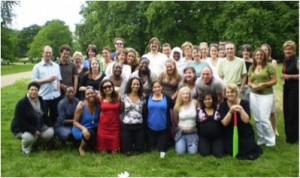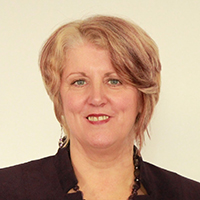A leading figure in the UK’s Further Education sector, Lynne Sedgmore CBE, shares her experience of developing a successful ‘Next Stage’ organisation.
As I read Frederic Lalouxs book, Reinventing Organisations, and his descriptions of Teal Organisations, I felt both recognition and inspiration as he is describing my own forays in leading organisations through explicit spiritual leadership, as a Chief Executive in England.
The most courageous FE leaders are discussing how to lead without traditional management structures and hierarchies, how to encourage autonomy and innovation to whole new levels
– Lynne Sedgmore

Laloux describes three innovative new organisational approaches which are revolutionary in that they transform hierarchy and power and move from traditional dominator, or top down, hierarchies to nested hierarchy.
The three approaches are ascertained from robust research grounded in organisational reality through inquiry in thirty organisations, twelve of which are featured in the book.
Firstly wholeness – deliberate practices to encourage everyone to “show up” in their true selves; secondly evolutionary purpose in which the organisation itself is viewed as having a creative spark of its own, with the role of leader to listen to where this organisation, as a complex entity, wants to go; and thirdly self-management in which any person can make a decision, as decisions are based upon consulting two groups to seek their advice through discourse – those with the necessary expertise and the people impacted by the decision.
Laloux points out that such approaches are not the norm in organisations but are arising as leaders and employees are looking for new ways to move away from dysfunctional and undesirable places to work in.
Reading through his checklists of the key elements involved in Teal structures, practices and processes I could tick most of the ones in wholeness and evolutionary purpose as ones co-created in three of my own organisations, particularly the national Centre for Excellence in Leadership (CEL), a government-funded centre, as described in Fry and Altman’s Spiritual Leadership in Action.
CEL began with five employees and grew to 80 full time, and 200 part-time associates in three years; it also expanded its budget from £2m to £16m. We attempted to co-create a healthy, successful and happy workplace to which staff could bring their whole selves through our individual and collective leading and fostering highly innovative organisational cultures, and harnessing of collective spirituality through six spiritually-explicit interventions as articulated in my own Doctorate, (DocProf) 2013, Fostering Innovative Organisational Cultures and High Performance through Explicit Spiritual Leadership: A Chief Executive’s Integrative Journey of Spirit and Leadership in the Workplace.
These six spiritually-explicit interventions came to a culmination in CEL from 2004-8 and are:
1. Living collectively from virtues, meaning, higher purpose and service
The values and culture of CEL encouraged open and free expression of who you considered yourself to be, as a person of faith or no faith, and that you belonged in the organisation however you identified. Values as truly lived and expressed were integrated into appraisal, providing two opportunities annually to reflect on the individuals’ living of values and virtues, and fostering a thoughtful and conscious connection to our collective purpose.
2. Fostering a spiritually intelligent, high-spirited community
CEL’s model of leadership was expansive and inclusive, and included all the intellectual, physical, social, emotional and spiritual dimensions. CEL’s collective underpinning philosophy encompassed leadership as a collective, distributed, and relational activity. This philosophy held moral purpose at its core and encouraged a distributed, student-centred, non-hierarchical, empowering leadership approach which encouraged all staff, at every level, to develop and lead to their fullest potential, including the spiritual dimension in peer working, beyond the formal role hierarchy, understanding that we are all interdependent.
3. Introducing spiritually informed policies and liberating processes
Liberating processes were introduced through a project named Democratising Strategy which engaged and involved all CEL staff in “a radically inclusive approach” to the articulation and decision-making of CEL’s strategic planning, through strategic forums, networking, open communication and creativity.
The project was approached from a systems mindset and involved forums for all staff; then an organisation-wide exchange process between all the forums, enabling the whole system of CEL to interact as a whole, interconnected system.
The project maximised staff participation in the CEL strategic process and built a culture that was emancipatory, where employees had agency to influence change and to create new thinking and physical spaces for openness, creativity and distributed leadership, as well as opportunities for the development of strategic thinking for junior staff.
4. Developing the whole person through fostering inner life, spiritual awareness, growth and inquiry
CEL staff were highly creative, articulate, autonomous individuals with a strong desire to continually learn and improve and to practice self-reflective skills. We co-created comprehensive processes for developing critical self-reflection and awareness, including the spiritual dimension, investing an average of £3,700 a year for each member of staff.
A range of coaching, mentoring and 360‑degree diagnostic and self-reflective tools were available, including the Global Executive Leadership Inventory, Myers-Briggs, Facet 24, the Enneagram, and the CEL Leadership Qualities Framework. Emotional and spiritual intelligence were valued.
Staff were encouraged to engage in whatever inner work appealed to them; engagement was not compulsory, and individuals engaged to whatever depth they chose. Meditation, massage, healing, and yoga were shared by CEL staff, as were stories, passions and hobbies, such as knitting, salsa dancing, hand massage and poetry on staff development events.
5. Celebrating and supporting spiritual pluralism and diversity
Commitment to diversity and dignity at work were core strands of the CEL mission alongside a core value of being “diverse” in that all differences were truly celebrated and respected, while seeing through to the unity and harmony of what, at the deepest spiritual core, bound staff together in meaningful and common purpose.
As part of the values dialogue, CEL was explicit about diversity, including gender, ethnicity, sexual orientation, age, disability and faith. Diversity awareness training was available for all staff and included space to explore all facets of diversity, however complex or challenging.
6. Respecting and responding to dissent and challenge
We held a unique balance in CEL of fostering high levels of individual expression as well as encouraging constructive dissent, simultaneously. We acknowledged dissent as an issue of power with sensitivity and safe spaces for staff to express their full, dissenting and true views, individually and collectively. Many suggestions, steeped in dissent and challenge, were acted upon. All staff were encouraged to speak truth to power and work together to keep everyone’s ego, excesses and flaws in check.
And the ever-important core question, did it work?
As the national leadership centre for Further Education, CEL was set targets by civil servants to develop 1,500 leaders in three years; within five years 40,000 leaders had participated. Bottom-line achievements included profits of between £0.5m and £1m a year, which were invested back into developmental projects, and a legacy of £3m surplus was left at the merger in 2008.
CEL also achieved 98% customer satisfaction, 82% market niche, significant repeat business, and robustly-evidenced impact and improvement. Every performance criterion was significantly outperformed. CEL developed 37 different leadership interventions designed to support and attract leaders at whichever stage they were, from Red to Teal on Spiral Dynamics, and from Technician to Alchemist on Torbert’s stages.
CEL was considered at the leading edge of leadership, not least winning the International Spirit at Work Award in 2007, only the second UK organisation to win, following the Body Shop.
Fry and Altman (p. 71-84) claim that CEL was highly successful in maximising spiritual capital and the triple bottom line – of people, planet and profits – and had established itself as a champion, by being at the leading edge of leadership development that included the spiritual and faith dimension of leadership, thus developing a model of good practice in organisational spirituality and in spiritual leadership for other organisations.
So why are some of us able to co-create Teal organisations and not others?
Laloux says it requires a certain way of seeing the world, a post-conventional mindset, one that has an integrated worldview and psychological development consistent with Teal developmental level. That may be true, and I have worked with Torbert’s levels and Spiral Dynamics for many years. I do know that it requires strength and understanding based on a well-developed inner life and a commitment to constant development.
I believe – in this time of financial austerity in the UK – that the climate of fear and mistrust will clamp down and diminish the efficacy of some leaders and organisations, but in others it will mean that taking risks and trying new approaches is the only option. In my sector, Further Education (FE), we are facing another round of cuts of 26%, on top of previous cuts.
There is not much lean, let alone any fat. Some leaders are leaving, others are finding new ways of being curious about what they can do differently. The most courageous FE leaders are discussing how to lead without traditional management structures and hierarchies, how to encourage autonomy and innovation to whole new levels. How to devolve power, as well as responsibility, to all parts of the organisation.
How to foster engagement and purpose in demoralised and exhausted staff. Why? Because the old ways are no longer affordable nor desirable. However hard change may be, it has to be better than an overwhelming diminishment or failure of the same.
I encourage all leaders to read Laloux’s inspiring book and to begin experimenting with new forms of non-hierarchical leadership and the flowering and contribution and wholeness of everyone involved throughout their organisation. His research offers clear evidence of what can work – with courage, clarity and persistence.
Reference
Fry L. and Altman Y. (2013) Spiritual Leadership in Action: The CEL Story, Charlotte USA: IAP press.

Lynne Sedgmore FRSA CBE is a leading figure in the UK’s Further Education sector – recently awarded a CBE in honour of her contribution. She is currently Executive Director of the 157 Group, a consortium of the UK’s largest FE colleges.





Thanks so much for this grounded, insightful commentary from your inspiring experiences, Lynne. I am truly inspired by your story and couldn’t agree more with the conclusions you reach.
Thanks Tom much appreciated Lynne xx
Dear Lynne,
Interesting that you use the word discourse, I would also add dialogue, as Bohm points out in his reference to be able to show up in the group through the collective, and utlising the language, to devolve and collectively agree, Now lets move forward to deliver challenging outcome and possibilities !
Bill, thx for pointing this out, just looked up in the dictionary, I should be using dialogue, I thought discoursing and dialogue meant the same, but totally wrong! Gosh cannot believe I made such a mistake. I totally agree it’s only through authentic dialogue can collective meaning making happen. Much appreciated xxxxx